Revisiting Taiko: Ethereum’s ZK-Rollup Equivalent
Golden Finance once again analyzed this leading zkRollup project that is equivalent to Ethereum in an attempt to find out more value.
 JinseFinance
JinseFinance
1. Project Introduction
Taiko is a decentralized Ethereum equivalent zkRollup project that aims to scale Ethereum through zkEVM technology.
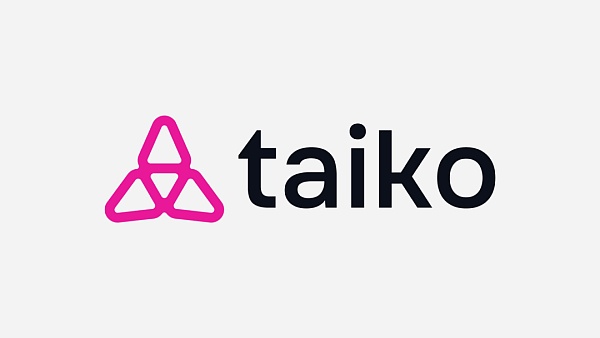
Taiko is committed to becoming a zkRollup that is completely equivalent to Ethereum in order to scale Ethereum without changing existing decentralized applications (dApps). As a zkRollup that is completely equivalent to Ethereum, Taiko allows developers and users to leverage the power of Ethereum Layer 1 (L1) without changing existing dApps.
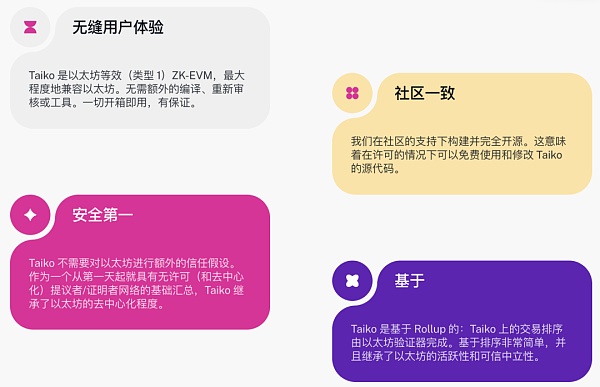
Main Features:
Fully EVM-compatible zkEVM Type 1: Taiko’s Type 1 zkEVM is fully compatible with Ethereum, enabling developers to migrate dApps between Ethereum and Taiko without worrying about smart contract failures.
Open Source: All of Taiko’s source code can be viewed, built, or edited on GitHub, making blockchain development not limited to a small team, but also to communities and developers around the world.
Fully Decentralized: In addition to its high compatibility with EVM, Taiko also attaches great importance to the decentralization of the protocol and plans to generate zkPs by submitting blocks and proofs through decentralized proposers and validators.
2. Core Technology Structure
2.1 zkEVM Circuit
The zkEVM (Zero-Knowledge Ethereum Virtual Machine) circuit is one of the core components of Taiko’s technical architecture. It uses zero-knowledge proofs (ZKPs) to verify the accuracy and integrity of Ethereum Virtual Machine (EVM) calculations. Through zkEVM, Taiko can expand Ethereum without changing existing smart contracts and decentralized applications (dApps) while maintaining Ethereum's security, decentralization, and compatibility.

2.1.1 Functions and Features
1. Zero-Knowledge Proof (ZKPs)
Verify Transactions: zkEVM circuits use ZKPs to verify the correctness of transactions without revealing the specific data of the transaction. In this way, the amount of data processing on the Ethereum mainnet can be reduced, thereby reducing transaction costs and increasing transaction speeds.
Confidentiality: ZKPs ensure the privacy of transactions, and only verified proofs will be submitted to the Ethereum mainnet.
2.Fully compatible with EVM opcodes
Support all EVM opcodes: zkEVM circuits fully support all EVM opcodes, which means that developers can seamlessly migrate their smart contracts and dApps to Taiko without any modifications.
Maintain Ethereum compatibility: This high level of compatibility allows existing Ethereum development tools and ecosystems to be used directly on Taiko, greatly facilitating developers.
3. Decentralization and Security
Decentralized Verification: zkEVM circuits support a decentralized verifier model, where anyone can participate in generating and verifying zero-knowledge proofs. This decentralized approach ensures the security and integrity of the system.
Ethereum L1 Verifier: Taiko's zkEVM circuit uses Ethereum Layer 1 verifiers to sort transactions, ensuring that the decentralized and security properties of Ethereum are inherited.
4. Efficient and Scalable
Reduce Data Processing: By executing transactions and generating zero-knowledge proofs on Layer 2, the amount of data processing on the Ethereum mainnet is reduced, thereby improving the efficiency and scalability of transactions.
Fast generation of zk proofs: The zkEVM circuit design optimizes the speed of zk proof generation to ensure that a large number of transactions can be processed efficiently.
5. Smart Contracts and Protocol Rules
Smart Contract Execution: The zkEVM circuit supports the execution of smart contracts to ensure the programmability and flexibility of Ethereum. These smart contracts are responsible for verifying zk proofs and enforcing protocol rules.
Protocol Verification: The zkEVM circuit ensures that all proofs and transaction states are strictly verified through integration with Ethereum L1, maintaining the consistency and security of the system.
2.1.2 How it works
1. Transaction execution and data collection
Transactions are first executed on Layer 2 to generate corresponding transaction data.
These transaction data will be collected and prepared for zk proof generation.
2. Zero-knowledge proof generation
The zkEVM circuit uses zkSNARKs or zkSTARKs technology to generate zero-knowledge proofs, which can verify the correctness of transactions without revealing the specific content of the transaction.
After the proof is generated, the proof and related data will be submitted to Ethereum L1.
3. Verification and Status Update
The Ethereum L1 validator verifies the submitted zero-knowledge proof to ensure the validity of the proof.
Once the proof is verified, the transaction status will be updated on the Ethereum mainnet to ensure that all participants see consistent transaction results.
2.2 Layer 2 Rollup Node
The Layer 2 Rollup node is a key component in the Taiko technical architecture, responsible for managing and executing transactions on Layer 2 while interacting with Ethereum Layer 1 (L1). Through Layer 2 Rollup technology, Taiko is able to increase Ethereum's transaction throughput, reduce transaction costs, and maintain decentralization and security.
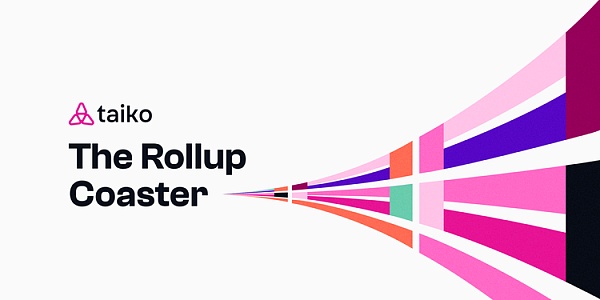
2.2.1 Functions and Features
1. Data Collection and Transaction Execution
Transaction Execution: Layer 2 Rollup nodes execute transactions on Layer 2, which are first processed in the Layer 2 network, reducing the direct burden on the Ethereum mainnet.
Data Collection: Nodes collect data transmitted from Ethereum Layer 1 and perform transaction processing and status updates based on this data.
2. State management
State display: After each transaction is executed, the Layer 2 Rollup node will update and display the transaction status to ensure that all participants see consistent status information.
State persistence: By managing the status after the transaction is executed, the consistency and data integrity of the entire network are ensured.
3. Protocol rule execution
Protocol verification: The Layer 2 Rollup node executes the transaction and verification process according to the rules of the Taiko protocol. These rules ensure the validity of the transaction and the security of the network.
Smart Contract Support: Nodes can execute smart contracts deployed on Ethereum Layer 1, using these contracts for data transmission and zk proof verification.
4. Efficient and Scalable
Increase throughput: By executing transactions on Layer 2, the transaction processing capacity of the network is greatly improved, reducing the congestion of the Ethereum main network.
Reduce costs: Processing transactions on Layer 2 can significantly reduce transaction fees, making small transactions more economical and feasible.
5. Decentralization and security
Decentralized verification: Layer 2 Rollup nodes support a decentralized validator model, and anyone can participate in the verification of transactions and the generation of zk proofs to ensure the decentralization and security of the network.
Data transmission: The node is responsible for transmitting transaction data on Layer 2 to Ethereum Layer 1 and updating the status based on the feedback from L1.
2.2.2 Working principle
1. Data collection and transaction execution
Receiving transactions: The node receives transactions submitted by users on Layer 2 and executes them according to the protocol rules.
Status Update: After the transaction is executed, the node updates the transaction status and maintains the latest status information on Layer 2.
2. Zero-knowledge Proof Generation
Generate ZK Proof: The node generates a zero-knowledge proof for each transaction to ensure the correctness and privacy of the transaction.
Submit Proof: The generated ZK proof and related data will be submitted to Ethereum Layer 1 for verification by L1 validators.
3. Verification and Status Update
L1 Verification: Ethereum Layer 1 validators verify the submitted zero-knowledge proof to ensure the validity of the transaction.
State synchronization: Once the proof is verified, the Layer 2 Rollup node will synchronize the state based on the feedback from L1 to ensure the consistency of the entire network.
Advantages and application scenarios:
1. Improve the scalability of Ethereum
1. Improve the scalability of Ethereum
By processing a large number of transactions on Layer 2, Taiko's Layer 2 Rollup node can significantly improve the scalability of the Ethereum network and meet higher transaction requirements.
2. Reduce transaction costs
Executing transactions on Layer 2 and generating zk proofs reduces dependence on the Ethereum mainnet, thereby reducing transaction fees, which is particularly suitable for application scenarios with high-frequency small transactions.
3. Enhanced security and privacy
Zero-knowledge proof technology ensures the privacy and security of transactions, avoids the leakage of transaction data, and maintains the decentralized nature of the network.
2.3 Taiko Protocol
The Taiko Protocol is also a core component of the Taiko technical architecture. It defines and executes the rules of Layer 2 Rollup to ensure the correctness of transactions and the security of the network. Through smart contracts and decentralized verification, the Taiko Protocol achieves efficient expansion of Ethereum while maintaining its decentralized and secure characteristics.
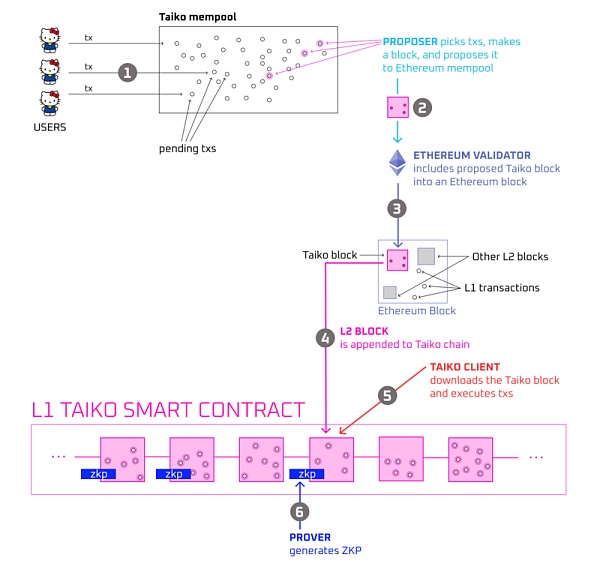
2.3.1 Functions and Features
1. Protocol Rule Definition
Rule Setting: The Taiko protocol defines all operating rules of Rollup, including transaction processing, verification, and status updates. All transactions must follow these rules to ensure the consistency of network operations.
Smart Contract Execution: The protocol is implemented through smart contracts deployed on Ethereum to ensure that all rules and operations are open and transparent.
2. Transaction Verification and Status Update
Transaction Verification: After each transaction is submitted, the Taiko protocol will verify it according to predefined rules to ensure the validity and correctness of the transaction.
Status Update: After the verification is completed, the protocol will update the transaction status of Layer 2 and transmit the relevant data to Ethereum Layer 1 to ensure state synchronization and consistency.
3. Decentralization and Security
Decentralized Validators: The Taiko protocol supports a decentralized validator model, and anyone can participate in the verification process. This decentralized approach enhances the security and integrity of the network.
Zero-knowledge proof: The protocol uses zero-knowledge proof technology (zkSNARKs or zkSTARKs) to verify transactions without exposing the specific content of the transaction, ensuring the privacy and security of the transaction.
4. Data transmission and processing
Data submission: Transaction data and the generated zk proof will be submitted to Ethereum Layer 1 for verification by L1 validators.
Data processing: After L1 verification, the protocol will update the status of Layer 2 based on the feedback to ensure that all participants see consistent transaction results.
5. Smart Contract Function
Data Transfer Mechanism: Smart contracts are responsible for transferring transaction data and zk proofs between Layer 2 and Layer 1 to ensure the integrity and consistency of the data.
Protocol Verification: Smart contracts are also responsible for verifying zk proofs to ensure the validity and correctness of transactions.
6. Governance and Community Driven
Decentralized Autonomous Organization (DAO): The governance of the Taiko protocol is managed by Taiko DAO, which is composed of TKO token holders who decide on major updates and changes to the protocol through voting.
Community participation: The governance and development of the protocol are highly dependent on the participation and contribution of the community to ensure that the decision-making of the protocol is transparent, fair and inclusive.
2.3.2 Working principle:
1. Transaction submission and execution
Users submit transactions on Layer 2, and the transactions are first executed on the Layer 2 Rollup node.
After the transaction is executed, the corresponding transaction data and status updates are generated.
2. Zero-knowledge proof generation
Generate zero-knowledge proofs to verify the correctness of transactions. These proofs will not expose the specific content of the transaction and ensure privacy.
The generated zk proof and transaction data will be submitted to Ethereum Layer 1.
3. L1 verification and status update
The Ethereum Layer 1 validator verifies the submitted zero-knowledge proof to ensure the validity and correctness of the transaction.
After the verification, the status of Layer 2 will be updated according to the feedback from L1 to ensure the consistency and security of the entire network.
4. Governance and protocol updates
Taiko DAO decides on protocol updates and changes through voting to ensure community participation and transparent governance.
All protocol updates will be implemented through smart contracts to ensure the openness and transparency of the rules.
2.3.3 Advantages and Application Scenarios
1. Improve the scalability of Ethereum
Through Layer 2 Rollup technology and zero-knowledge proof, the Taiko protocol significantly improves the scalability of the Ethereum network, and can handle more transactions and meet higher transaction requirements.
2. Reduce transaction costs
Processing transactions on Layer 2 reduces dependence on the Ethereum mainnet, thereby reducing transaction fees, which is particularly suitable for application scenarios of high-frequency small transactions.
3. Enhanced security and privacy
Zero-knowledge proof technology ensures the privacy and security of transactions, avoids the leakage of transaction data, and maintains the decentralized nature of the network.
4. Community-driven and transparent governance
Through Taiko DAO, community members can participate in the governance and decision-making of the protocol to ensure that the development direction of the protocol is in line with the interests and needs of the community.
2.4 Base Competitive Rollup (BCR)
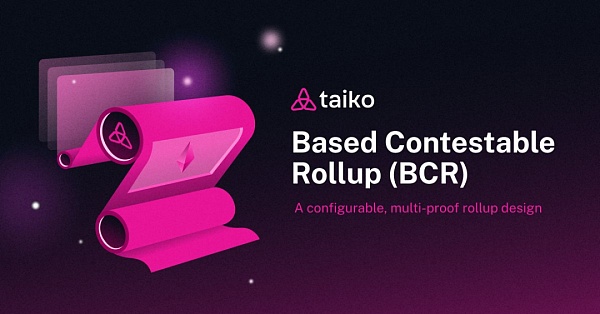
Base Competitive Rollup (BCR) is a key innovation in the Taiko protocol that aims to enhance the decentralization and security of the network. The following is a detailed introduction to BCR:
2.4.1 Core Concepts
BCR is an innovative Layer 2 solution that aims to improve the decentralization and security of blockchain networks through a competitive mechanism. In the BCR model, multiple participants can compete to propose and verify blocks, eliminating the control of a single entity over the network.
2.4.2 Working Mechanism
1. Competitive Proposals
Proposers: Anyone can become a proposer and submit a block proposal. The proposer needs to package user transactions and generate zero-knowledge proofs (zkProofs).
Proposal Competition: Multiple proposers can compete to submit blocks at the same time, ensuring that the generation and submission process of each block is decentralized, without a single centralized control point.
2. Verification process
Verifiers: Verifiers are responsible for verifying the blocks and zero-knowledge proofs submitted by the proposer. They ensure the security of the network by verifying the correctness and legitimacy of the transaction.
Competitive verification: Multiple verifiers can compete to verify blocks, which increases the security of the network because the competition between verifiers ensures the accuracy and transparency of the verification process.
2.4.3 Advantages of BCR
1. Enhanced decentralization
Open participation: The BCR model allows anyone to participate in block proposals and verification, eliminating the reliance on a few entities and enhancing the decentralization of the network.
Anti-censorship: With multiple proposers and validators competing, it is difficult for any single entity to censor or control the network.
2. Improved security
Multiple verification: Through a competitive verification mechanism, multiple validators independently verify blocks, which ensures the reliability and security of the verification process.
Reduce single point of failure: The BCR model reduces the risk of single point of failure because the operation of the network does not depend on a single proposer or validator.
3. Economic incentives
Fair competition: Proposers and validators receive economic rewards through competition, and this mechanism ensures that participants are motivated to provide honest and efficient services.
Fee burning: Proposers need to burn a certain number of TKO tokens to submit blocks, which helps control token supply and stabilize token value.
2.5 Booster-Based Rollup (BBR)
Booster-Based Rollup (BBR) is a key component of the Taiko protocol, designed to further expand the capabilities of the Ethereum network by improving transaction execution and storage efficiency. The design goal of BBR is to create a seamless user and developer experience that enables transactions to be executed as if on Layer 1 (L1) while maintaining their own storage on Layer 2 (L2).
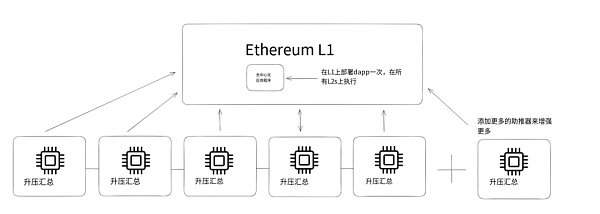
2.5.1 Core Features and Working Principles
1. Two-layer Structure
Separation of Execution and Storage: BBR implements a two-layer structure of transaction execution and storage. This design enables transactions to be executed efficiently on L2 while maintaining the necessary security and decentralization on L1.
Seamless Integration with L1: Through this two-layer structure, BBR enables smart contracts to maintain consistent addresses on L1 and all BBR, simplifying the deployment and interaction process.
2. Compatibility and Scalability
Fully Compatible with Ethereum: BBR is fully compatible with Ethereum's existing architecture, including hash functions, state trees, and gas fees for each opcode. This means that existing Ethereum smart contracts and dApps can be seamlessly migrated to BBR.
Enhanced Scalability: BBR is designed to improve Ethereum's scalability, making transactions faster and less expensive, thereby supporting a larger scale of users and applications.
3. Booster Function
Universality: BBR's booster function can enhance any type of summary, whether it is optimistic summary or zero-knowledge summary, and can take advantage of the expansion capabilities provided by BBR.
Enhanced Ethereum scalability: With BBR, any rollup can directly enhance Ethereum's scalability, enabling it to handle more transactions and more complex applications.
2.5.2 Technical details
1.Consistency of smart contracts
Address consistency: BBR ensures that the smart contract addresses on L1 and L2 are consistent, which means that the smart contracts deployed by developers on L1 can run seamlessly on L2, simplifying the development and deployment process.
Simplified interaction: The interaction process between users and developers at different layers is simplified, ensuring the consistency of user experience and the convenience of the development process.
2. Economic Incentive Mechanism
Fee Structure: BBR's fee structure is well designed to ensure that transaction fees are low enough to encourage users and developers to use it, while ensuring that the network's economic incentive mechanism is strong enough to maintain the enthusiasm of validators and proposers to participate.
Reward Distribution: Through a reasonable reward distribution mechanism, BBR ensures that all participants receive fair incentives in the network, thereby maintaining the decentralization and security of the network.
2.5.3 Advantages
1. Improve transaction efficiency
Fast transaction processing: By executing transactions on L2, BBR significantly improves transaction processing speed and reduces the burden on the Ethereum mainnet.
Reduce transaction costs: Executing transactions on L2 significantly reduces transaction costs, making small transactions and high-frequency transactions more economically feasible.
2. Enhanced network security
Decentralized verification: BBR adopts a decentralized verification mechanism to ensure the security and decentralization of the network, avoiding single point failure and censorship risks.
Multiple verification mechanism: Through the multiple verification mechanism, BBR provides higher security guarantees to ensure the correctness and legality of all transactions.
3. Optimize user experience
Seamless user experience: BBR is designed to ensure that users have the same experience as L1 when using the L2 network, without having to worry about complex technical details.
Easy to develop and deploy: Developers can use existing Ethereum tools and infrastructure to easily develop and deploy smart contracts and dApps on BBR.
3. TKO Token
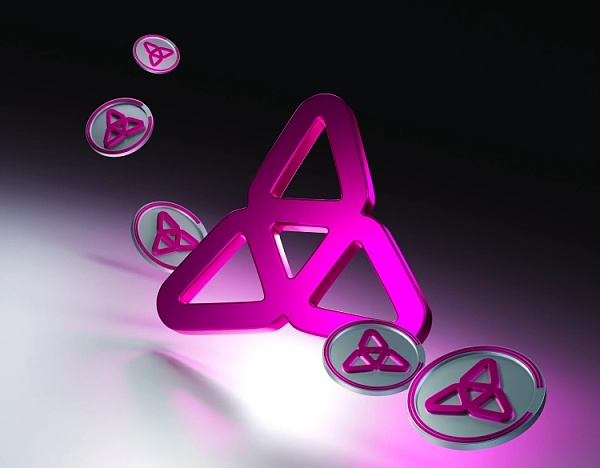
TKO is the native token of the Taiko network, designed to reward block validators and as part of the transaction fees in the Taiko network.
3.1 Token Function
Transaction Fees: When users make transactions on the Taiko Layer 2 network, they need to pay transaction fees, which will be collected by block proposers. Block proposers must burn a certain number of TKO tokens and pay Ethereum validators ETH to ensure that their blocks are included in the Ethereum Layer 1 network.
Reward Mechanism: TKO tokens are used to reward block validators, who ensure the validity of transactions by generating and verifying zero-knowledge proofs (zkProofs). The transparency of TKO tokens ensures that the user experience is similar to that on the Ethereum network.
Margin System: TKO tokens are used in the margin system of BCR and BBR, ensuring the integrity and timeliness of network operations. Confiscated margins are not lost, but redirected to the Taiko Treasury on L1.
Governance Role: TKO token holders can participate in network governance, influence network upgrades and manage the Taiko Treasury, maintaining the permissionless nature of the network on L1 and L2.
3.2 Token Supply
Total Supply: 1 billion TKO tokens, with 18 decimal places.
Token Management: The minting or destruction of TKO tokens is strictly carried out in accordance with the governance regulations, ensuring that supply changes are transparent and reflect the consensus of token holders. Token Distribution
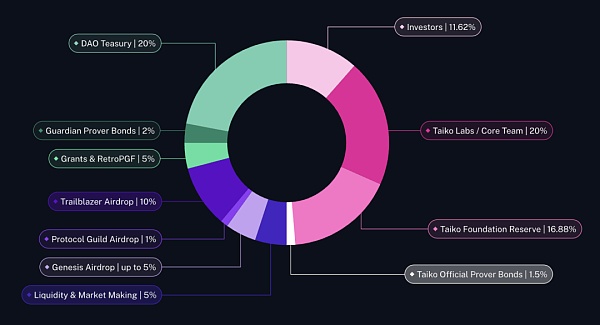
DAO Treasury:20%
Guardian Prover Bonds:2%
Grants & RetroPGF:5%
Trailblazer Airdrop: 10%
Protocol Guild Airdrop: 1%
Genesis Airdrop: Up to 5%
Liquidity and Market Making: 5%
Investors: 11.62%
Taiko Labs/Core Team: 20%
Taiko Foundation Reserve: 16.88%
Taiko Official Prover Bonds: 1.5%
3.4 Token Airdrop
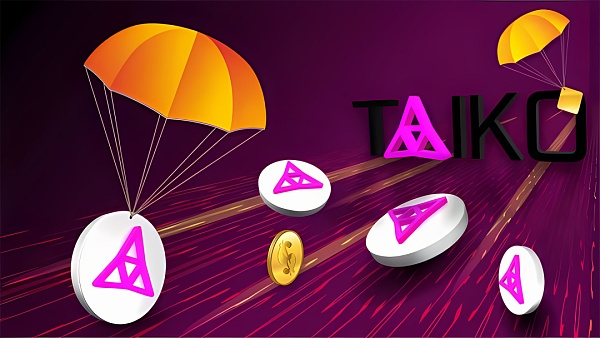
1.Testnet Interaction:
To increase the chances of getting TKO token airdrops, users can participate in Taiko’s testnet and increase the possibility of airdrops by interacting with its testnet.
At present, Taiko has conducted multiple testnets, the latest testnet is Alpha3, which is designed to test the interaction between proposers and validators, as well as the new fee and incentive system.
2. Steps to participate:
Add network: Add Sepolia network and Taiko's Alpha3 testnet to your MetaMask wallet.
Get testnet ETH: Get Sepolia ETH from the faucet.
Mint and bridge tokens: Connect your wallet, mint Bull and Horse tokens, and add these tokens to your MetaMask, then bridge ETH, BLL and Horse from Sepolia to Taiko.
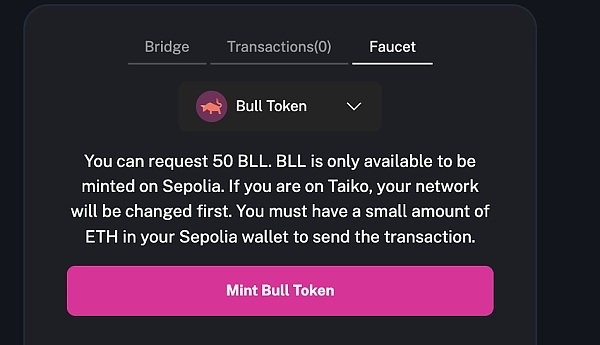
Swap and provide liquidity: In Taiko's swap test, import Taiko's token list, swap and provide liquidity for some tokens.
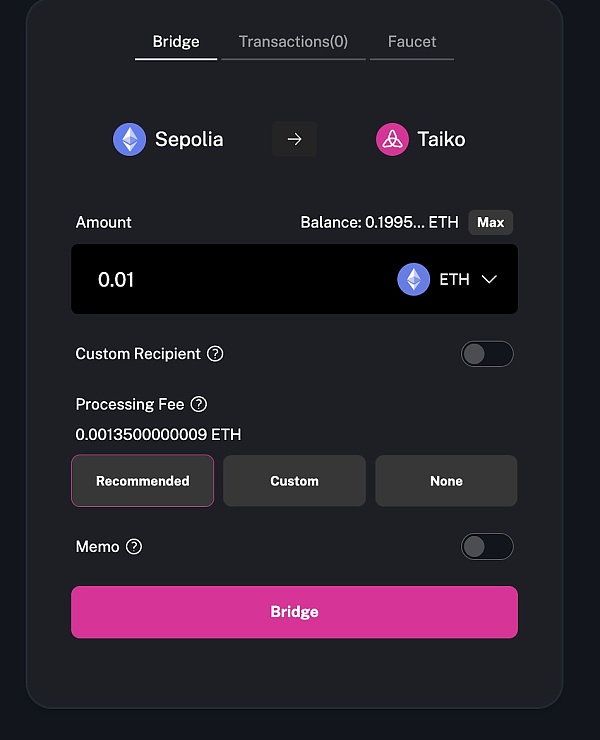
Developer tasks: For users with some development experience, you can deploy and verify contracts, or follow the guide to build a dApp.
Complete tasks: Visit Taiko's Galxe page and complete tasks such as transferring, exchanging funds, visiting pages, or answering quizzes to earn points, which may be converted into future rewards.
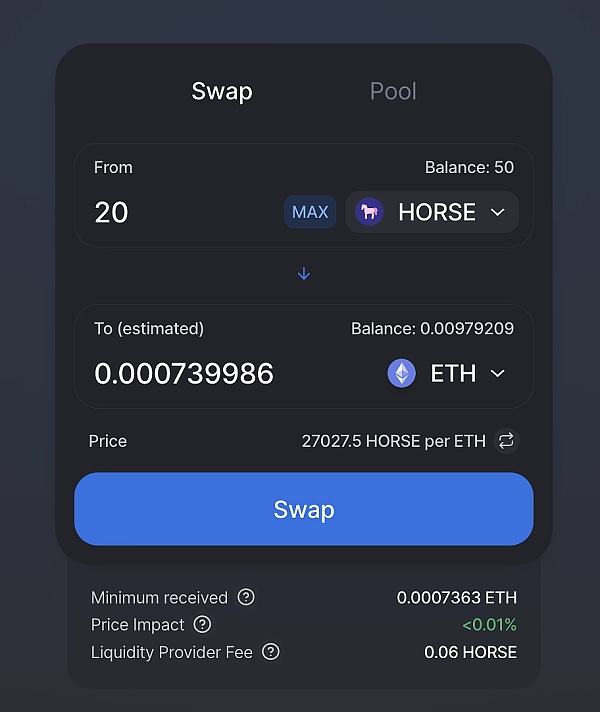
4. Community and Ecosystem Development
According to the official Taiko website, more than 90 projects have been integrated into the ecosystem.
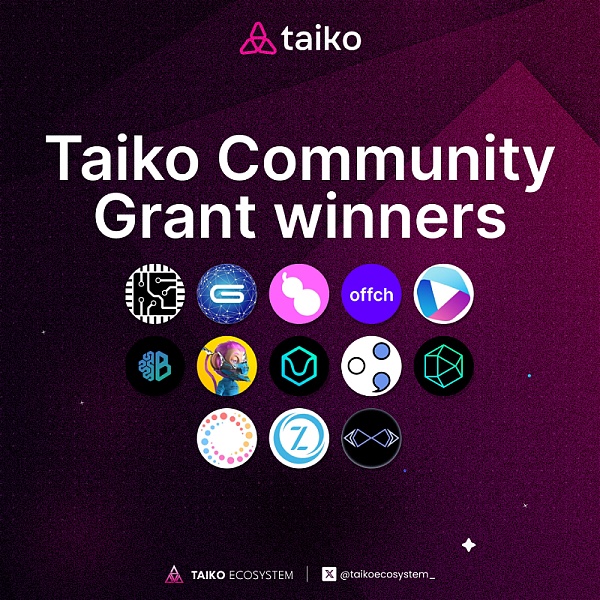
These projects cover a variety of sectors, including wallets (with a notable EVM native wallet), NFT markets (with single-chain and multi-chain options), infrastructure (such as RPC and oracle services), and DeFi applications. As a Type 1 Layer2 solution, Taiko provides a seamless migration path for Ethereum dApps with little to no adjustments.
In addition, the Taiko team has introduced a test token faucet, an official token and NFT bridge, as well as an exchange function and a browser.
As of May 23, 2024, Taiko has 933,000 followers on the X (Twitter) platform, and Discord has accumulated 9,094,000 members. In comparison, Optimism has 640,000 followers and Arbitrum has 980,000 followers. Taiko's community has shown significant growth and engagement.
5. Team/Financing
5.1 Team
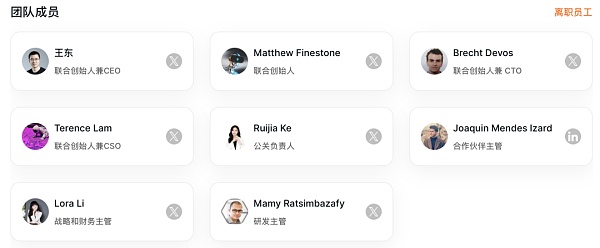
The Taiko team consists of experienced blockchain experts and engineers with deep background and rich experience in blockchain technology, cryptography and distributed systems.
Co-founder Daniel Wang was the founder and former CEO of Loopring, an Ethereum-based decentralized trading protocol that uses zero-knowledge proof technology for expansion. As a veteran in the blockchain industry, Daniel has extensive experience in blockchain technology and decentralized finance (DeFi). In Taiko, Daniel Wang is responsible for overall strategic planning and technical guidance to drive the development and innovation of the project.
Brecht Devos is the co-founder and head of the zero-knowledge research and development team. He was the former chief architect of Loopring and has a deep background in cryptography and blockchain technology. He has extensive practical experience in zero-knowledge proof technology and blockchain protocol design. In Taiko, Brecht leads the zero-knowledge research and development team, focusing on the research and development and implementation of zkRollup and zkEVM technologies.
Organizational Structure
To ensure the effective operation of the Taiko network and compliance with regulatory requirements, Taiko has established multiple related entities and organizations, among which several key entities play key roles:
Taiko Labs: A dedicated R&D team focused on advancing the Taiko protocol.
Taiko Treasury: Funded by revenue generated by the Taiko protocol, the Treasury is the financial resource for the project.
Taiko DAO: This organization is composed of holders of Taiko tokens (TKO) and exercises voting rights to manage various aspects of the Taiko protocol. This includes decisions on smart contract upgrades, TKO parameters, and other protocol-related matters.
Taiko Foundation: As a legal entity based in the Cayman Islands, the Taiko Foundation oversees the growth and development of the Taiko Protocol and its broader ecosystem. The Foundation exclusively provides financial support for technology development, ecosystem expansion, maintenance, partnerships with service providers, event management, and other initiatives through grants or alternative financing methods on behalf of Taiko DAO and token holders.
Taiko Security Council: The Security Council is composed of individuals and entities selected by the Taiko Affairs Bureau and is responsible for taking prompt action in emergency situations as required by the Taiko Protocol. The Security Council's primary mission is to maintain the security and integrity of Taiko, authorizing them to implement upgrades or modifications to achieve this goal. 5.2 Financing
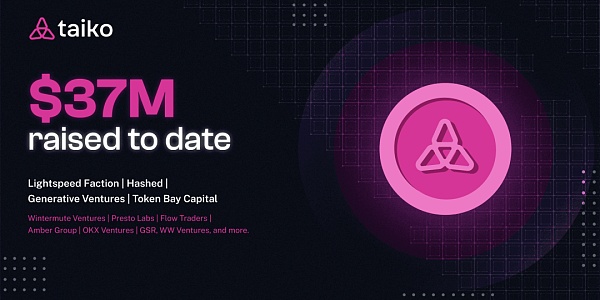
First financing and subsequent financing
Amount: US$22 million
Time: Including two rounds of financing announced on June 8, 2023
Investors: Sequoia China and Generative Ventures led the round, respectively, with participation from BAI Capital, GGV Capital, GSR Markets, IOSG Ventures, KuCoin Ventures, Mirana Ventures, OKX Ventures, Skyland Ventures, Token Bay Capital, Yunqi Partners, and other investors and notable contributors.
Latest Financing
Amount: US$15 million
Time: March 2, 2024
Investors: Led by Lightspeed, Faction, Hashed, Generative Ventures and Token Bay Capital, other investors include Wintermute Ventures, Presto Labs, Flow Traders, Amber Group, OKX Ventures, GSR and WW Ventures.
These funds are used for the deployment and optimization of multiple test networks, including Alpha1, Alpha2 and Alpha3 test networks, to verify and improve network design. Prepare for the mainnet launch at the end of the first quarter of 2024, including infrastructure construction and technical support.
6. Project Evaluation
6.1 Track Analysis
The Taiko project belongs to the Ethereum Layer 2 expansion solution track, specifically the zkRollup technology field. Taiko provides efficient, secure and decentralized blockchain expansion solutions through zero-knowledge Ethereum Virtual Machine (zkEVM) technology, aiming to solve Ethereum's scalability issues while maintaining full compatibility with Ethereum.
In the field of Ethereum Layer 2 expansion solutions, especially zkRollup technology, there are several similar projects:
1. zkSync
Introduction: zkSync is an Ethereum Layer 2 expansion solution based on zkRollup technology, aiming to provide fast and low-cost transactions while maintaining Ethereum's security and decentralization.
Features: Fully compatible with Ethereum, supports smart contracts, and focuses on user experience and developer friendliness.
2. StarkNet
Introduction: StarkNet is a Layer 2 expansion solution based on STARK (Scalable Transparent Argument of Knowledge) technology developed by StarkWare.
Features: Use STARK technology for zero-knowledge proof, provide high throughput and low-latency transactions, and support complex smart contracts.
3. Loopring
Introduction: Loopring is a zkRollup project focusing on decentralized trading (DEX) protocols, committed to providing efficient trading experience and low fees.
Features: Through zkRollup technology, high-throughput decentralized transactions are achieved, ensuring the security and privacy of user assets.
6.2 Project Advantages
Permissionless and Decentralized: Taiko stands out as a pioneering rollup-based solution by eliminating centralized sequencers and relying on Ethereum validators for transaction and block sorting.
Seamless developer experience:Taiko's use of ZK-EVM (Type 1 ZK-EVM) ensures compatibility with Ethereum execution standards, laying the foundation for a scalable Ethereum ecosystem.
Highly adaptable and future-proof:As a controversial Rollup, Taiko empowers application chains to customize their proof system and accept more efficient proofs as technology advances without modifying Taiko's core protocol.
Strong community support:Taiko's multiple testnets (Alpha1, Alpha2, and Alpha3) encourage community members to participate, and by interacting with the testnet, users can earn airdrops. This not only increases community activity, but also helps verify and optimize network design.
Extensive partners: Taiko has established strategic partnerships with a number of leading blockchain projects and companies to jointly promote the development of the ecosystem. These partners have provided important support in technology research and development, marketing and community building.
Financing support
Sufficient funds: Taiko has raised a total of US$37 million through multiple rounds of financing and has received support from a number of well-known investment institutions including Lightspeed, Faction, Hashed, Generative Ventures and Token Bay Capital. Sufficient funds provide a solid guarantee for technology research and development, team expansion and infrastructure construction.
6.3 Insufficient projects
1. Market competition
Fierce competitive environment: In the field of Ethereum Layer 2 expansion solutions, there are multiple strong competitors, such as zkSync, StarkNet, Loopring, Optimism and Arbitrum. These projects are also actively developing their technologies and ecosystems, and Taiko faces fierce market competition pressure.
Competitive Advantages: Although Taiko has certain advantages in technological innovation and community building, it is still a challenge to stand out from many competitors.
2. Technical Implementation
Technical Complexity: zkEVM and zkRollup technologies themselves are highly complex and require a lot of R&D investment and technical support. There are still technical challenges in achieving fully decentralized and efficient zero-knowledge proofs.
Mainnet Release: Taiko's mainnet is scheduled to be released at the end of the first quarter of 2024. Although multiple testnets have been successful, the smooth launch and widespread application of the mainnet still need further verification.
3. User Adoption
User Experience: Although Taiko offers many technical advantages, how to improve the user experience and attract more users and developers to use its network is still an important issue. In particular, continuous optimization is needed in terms of user habits and compatibility of developer tools.
Education and Promotion: More education and promotion activities are needed to help users and developers understand and use the Taiko network, especially in terms of complex zero-knowledge proof technology and decentralized governance models.
7. Conclusion
In summary, the Taiko project provides an efficient, secure, and decentralized expansion solution for Ethereum through innovative zkRollup and zkEVM technologies. With the support of multiple rounds of financing and the governance model of a decentralized autonomous organization (DAO), Taiko has made significant progress in technology research and development and community building. Despite market competition and technical challenges, Taiko is expected to occupy an important position in the field of blockchain expansion solutions by continuously optimizing technology and expanding the ecosystem, providing users and developers with an efficient and secure blockchain environment.
Golden Finance once again analyzed this leading zkRollup project that is equivalent to Ethereum in an attempt to find out more value.
 JinseFinance
JinseFinanceGolden Finance launches "Golden Web3.0 Daily" to provide you with the latest and fastest game, DeFi, DAO, NFT and Metaverse industry news.
 JinseFinance
JinseFinanceThe modular track has just begun, and RPC nodes are also a hard requirement. When the two are combined, I believe this project will be very promising.
 JinseFinance
JinseFinanceExplore Taiko, a pioneering decentralized ZK-Rollup designed to tackle Ethereum's scalability challenge, enhancing throughput while maintaining transparency and decentralization.
 Xu Lin
Xu LinThe alpha-3 test network’s primary purpose is to evaluate the economic design and implementation of new protocols, including new fee/reward structures.
 Others
OthersOn February 21st, 2023, LayerZero launched a bridge between mainnet ETH and Goerli testnet ETH.
 Coinlive
Coinlive Aave Companies, the firm behind the eponymously-named lending and borrowing protocol, are launching its native stablecoin GHO on the Ethereum Goerli testnet.
 decrypt
decryptThe blockchain network has continued to perform optimally despite the setback.
 Beincrypto
BeincryptoShardeum is an EVM-based, linearly scalable smart contract platform; it's currently in the testnet period and the mainnet will launch in Q2 of 2023.
 Tristan
TristanOn a historic day in the history of Ethereum, the network’s oldest testnet Ropsten was able to complete “The Merge”. ...
 Bitcoinist
Bitcoinist